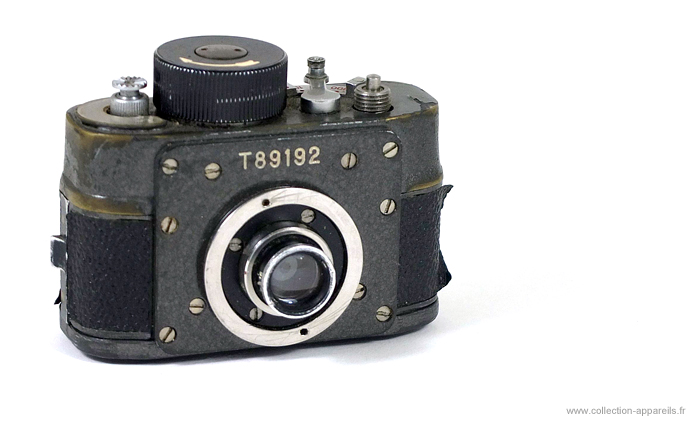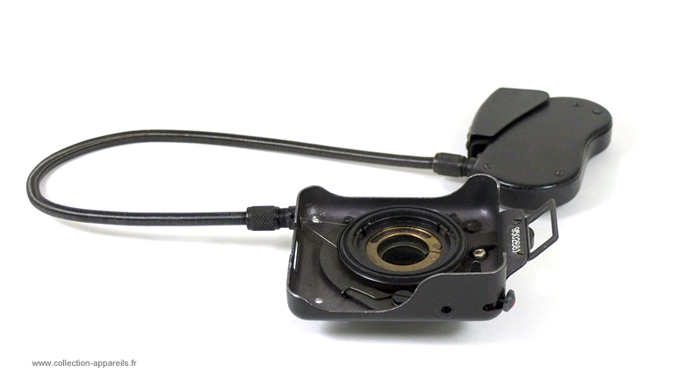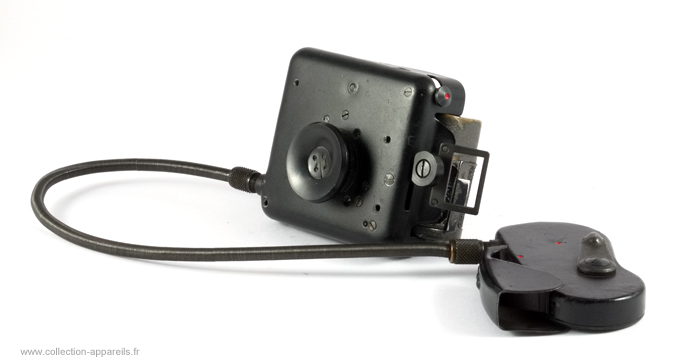|
Krasnogorsk F21 Ajax-12 |
Manufactured or assembled in Former USSR from 1953 to 1994.
Index of rarity in France: Rare (among non-specialized garage sales)
Inventory number: 14240
See the complete technical specifications
Chronology of cameras Krasnogorsk
The history of the Krasnogorsk F21, also known as Ajax, began in 1945 with the creation of the first Special Photographic Equipment Laboratory of the NKVD1. This laboratory was tasked with developing miniature spy cameras by miniaturizing the Luftwaffen-Robot. In 1949, it came under the control of the MGB2 and later, in 1959, became the 11th laboratory of the Operational Technical Directorate of the KGB. It was during this period that the first prototype of the special surveillance camera, the Ajax-8, was manufactured. However, the Ajax-8 had several flaws, including an inefficient mechanical motor, excessive noise during shutter release, and a low-quality A-1 4.5/28mm lens. In the same year, the Ajax-9 was introduced, featuring the same motor as the Robot and an improved A-4 2/28mm lens.
In 1950, a new model, the Ajax-10, was released with better internal coating to prevent film scratches and more user-friendly adjustment buttons. It could also be equipped with various accessories, such as the first systems for concealing the camera under a coat, leaving only a simple button exposed.
In 1951, the first truly operational camera, the Ajax-11, was introduced. It was much more reliable, produced higher-quality negatives, and significantly reduced shutter noise. It was at this point that production was transferred to the Krasnogorsk factories.
In 1952, the last model, the Ajax-12, was renamed the F-21, which was its internal production number at the factory. Its only difference from the Ajax-11 was the automatic resetting of the frame counter when changing the film.
Production of the F-21 continued until the fall of the Berlin Wall in 1989. During the 1990s, it was marketed to the general public as the Zenit MF-1 under the KMZ brand.
The Ajax cameras were used by the intelligence services of Warsaw Pact countries and were accompanied by a formidable array of camouflage accessories, including radio sets, belt buckles, 8mm cameras, handbags, books, and more.
1 Narodniï Komissariat Vnoutrennikh Diel : People's Commissariat for Internal Affairs 1934 - 1954
2 Ministerstvo Gossoudarstvennoï Bezopasnosti : Ministry of State Security 1946 - 1954.
Ce modèle est le premier de la série des Ajax a pouvoir être nommé F-21.
Il est présenté ici avec l'accessoire permettant de le cacher sous un manteau, en utilisant un faux bouton pour camoufler l'objectif. La poignée permet de déclencher depuis une poche du manteau. Le faux bouton s'ouvrait automatiquement lors du déclenchement.



Interesting links or bibliography :
| The Secret History of KGB Spycameras (Melton, Alekseenko, Hasco & Vreisleben), suggested by Sylvain Halgand |
Add a link or element of bibliography, a picture taken with this camera, a picture of box or an ads about this camera
Your photos taken with the same camera:
Cameras from Ebay France (Krasnogorsk) (Uploaded each 3 hours)








